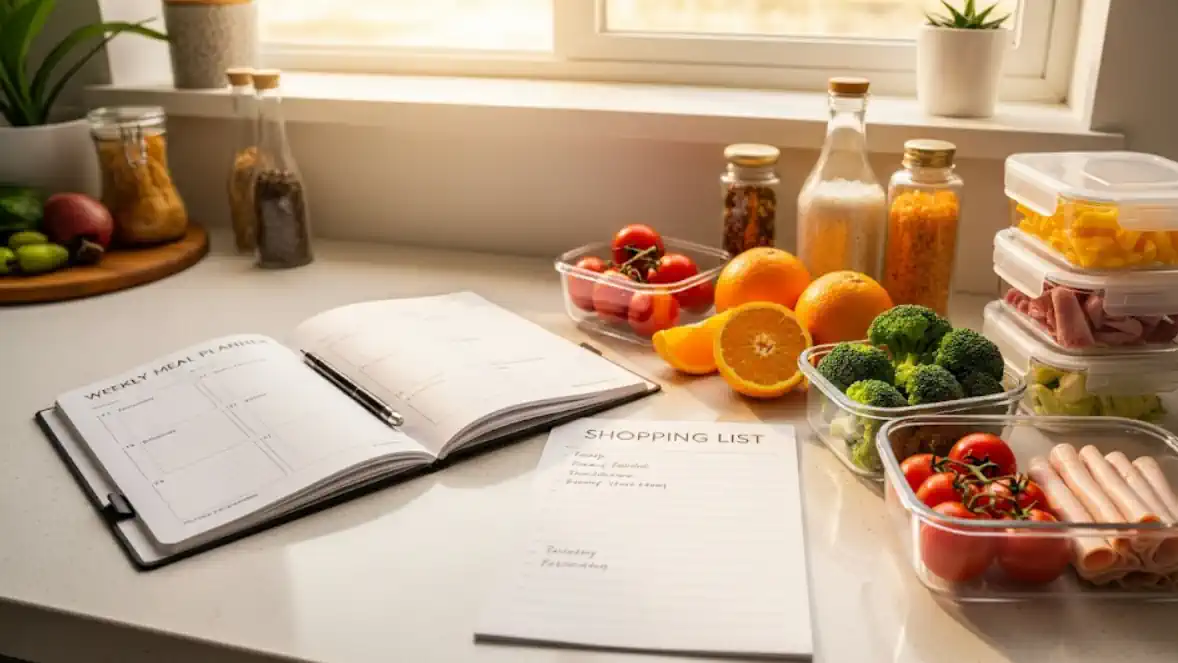It’s late Sunday morning, a time when the week ahead begins to come into focus. As we think about our upcoming work schedules, family commitments, and personal goals, one crucial question often gets pushed to the last minute: “What are we going to eat?”
In the hustle and bustle of our daily lives, it’s all too easy to fall into a routine of last-minute decisions. This often leads to either reaching for quick, processed options or repeatedly cooking the same few dishes. While comforting, these habits can make it challenging to maintain a consistently healthy and balanced diet.
This is where the power of effective meal planning comes in. It’s a simple yet transformative practice that allows you to take control of your nutrition, save time and money, and reduce stress. It’s the secret to ensuring that you and your family can enjoy nutritious and delicious home-cooked meals, even on the busiest of days.
Why Meal Planning is a Game-Changer for a Healthy Lifestyle
Before diving into the “how,” let’s appreciate the “why.” Committing a little time to planning your meals can have a massive positive impact on your week.
- You’ll Eat Healthier: When you have a plan, you are in control of the ingredients. You can intentionally incorporate more vegetables, lean proteins, and whole grains, while limiting processed foods, excess oil, and sugar.
- You’ll Save Time: Imagine coming home after a long day and knowing exactly what’s for dinner, with many of the ingredients already prepped. Meal planning eliminates the daily indecision and last-minute rushes to the store.
- You’ll Reduce Stress: The daily mental load of figuring out what to cook for breakfast, lunch, and dinner is significant. A plan removes this recurring stressor, freeing up your mental energy for other things.
- You’ll Save Money: Planning your meals means you buy only what you need, which drastically reduces food waste. It also makes you far less likely to resort to expensive takeaway or restaurant meals on a whim.
A Step-by-Step Guide to Effective Meal Planning
Getting started is simpler than you think. Here’s a practical approach you can follow today.
Step 1: Take Stock of Your Kitchen Before you plan anything, look at what you already have. Check your pantry, fridge, and freezer. What grains, lentils, spices, and vegetables do you have on hand? Planning meals around these items is a great way to start and helps prevent spoilage.
Step 2: Plan Your Meals for the Week Sit down with a notebook or a digital app and map out your meals for the coming week. Be realistic. You don’t have to plan every single snack. Start with dinners, as they are often the most challenging.
- Check Your Calendar: Note any days you’ll be eating out or have special events.
- Theme Your Days (Optional): To make it fun and simple, you could have themes like “Meatless Monday,” “Taco Tuesday,” or “New Recipe Friday.”
- Incorporate Seasonal Produce: Think about what’s fresh and in season at your grocery store or local market. Planning with seasonal vegetables is not only more affordable but also ensures your food is at its nutritional peak.
Step 3: Find Your Recipes Gather the recipes for your planned meals. This could be from family traditions, cookbooks, or online sources. Aim for a balance of familiar favourites and one or two new recipes to keep things interesting. Think about how you can create healthier versions of beloved dishes.
Step 4: Create a Smart Shopping List Go through your recipes and list all the ingredients you need, organized by category (e.g., vegetables, dairy, grains, protein). Cross-reference this with the inventory you took in Step 1. This organized list will make your shopping trip faster and more efficient.
Step 5: Schedule Prep Time This is the step that makes your weeknights so much easier. Set aside a couple of hours on the weekend to “meal prep.” You don’t have to cook full meals. Even small prep tasks can make a huge difference.
Meal Prep Strategies for Success
- Batch Cook Grains: Cook a large batch of rice, quinoa, or millets to use in different meals throughout the week.
- Wash and Chop Vegetables: Pre-chop onions, bell peppers, carrots, and other sturdy vegetables. Store them in airtight containers in the fridge. This makes throwing together a stir-fry or sabzi incredibly fast.
- Prepare Proteins: Marinate meats, boil eggs, or cook a batch of lentils or chickpeas so they are ready to be added to salads, curries, and wraps.
- Portion Snacks: Divide nuts, seeds, yogurt, or fruit into grab-and-go containers for healthy, easy snacks.
Making Your Meals Nutritious and Delicious
Healthy eating should never be boring. Here’s how to ensure your planned meals are something to look forward to.
- Eat the Rainbow: Aim to include a variety of colourful fruits and vegetables in your meals. Different colours signify different vitamins, minerals, and antioxidants.
- Focus on Flavor: Don’t rely on just salt, fat, or sugar for flavour. Explore the world of herbs and spices. A squeeze of lemon or lime can brighten up a dish, while fresh ginger, garlic, and herbs can add incredible depth.
- Don’t Fear Healthy Fats: Incorporate sources of healthy fats like avocados, nuts, seeds, and olive oil. They are essential for brain health and add to satiety.
Your Journey to a Healthier Lifestyle
Effective meal planning is a skill that gets easier and faster with practice. Start small. Perhaps just plan your dinners for the next three days. Once you feel the benefits—the calm, the control, the delicious and healthy food—you’ll be motivated to continue. By investing a little time in planning, you are giving yourself the gift of a healthier, less stressful, and more delicious week.
